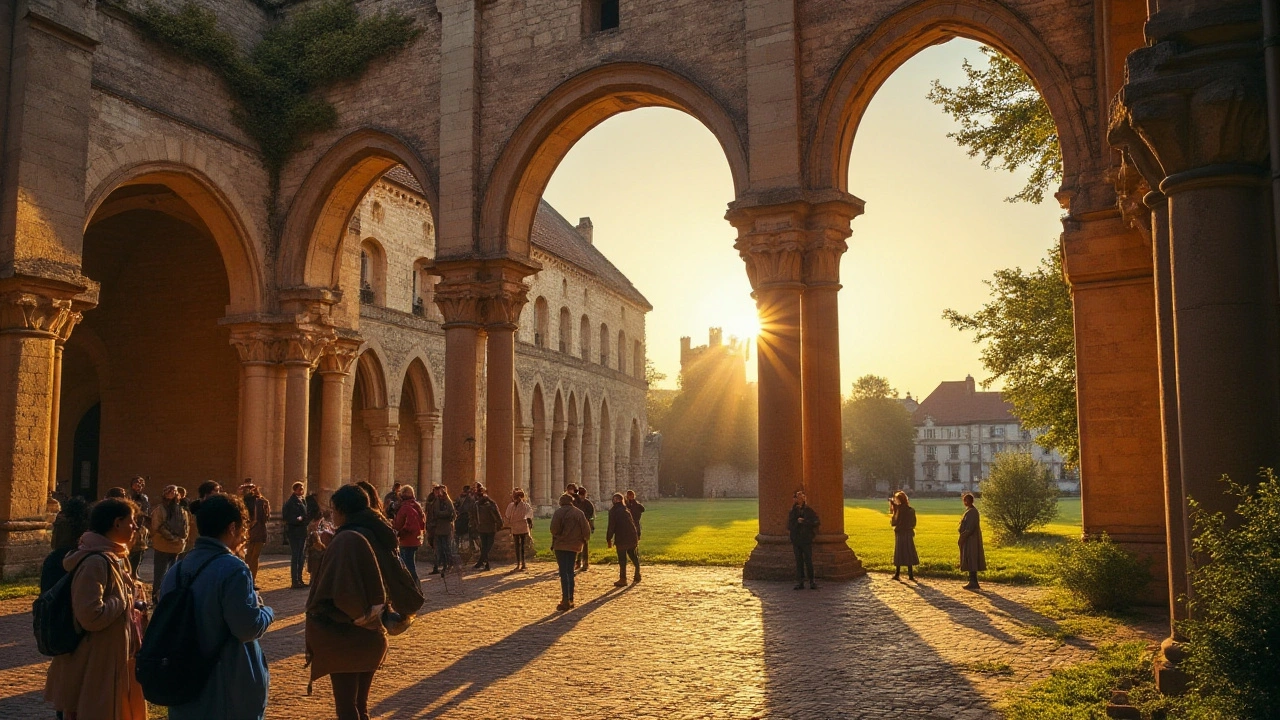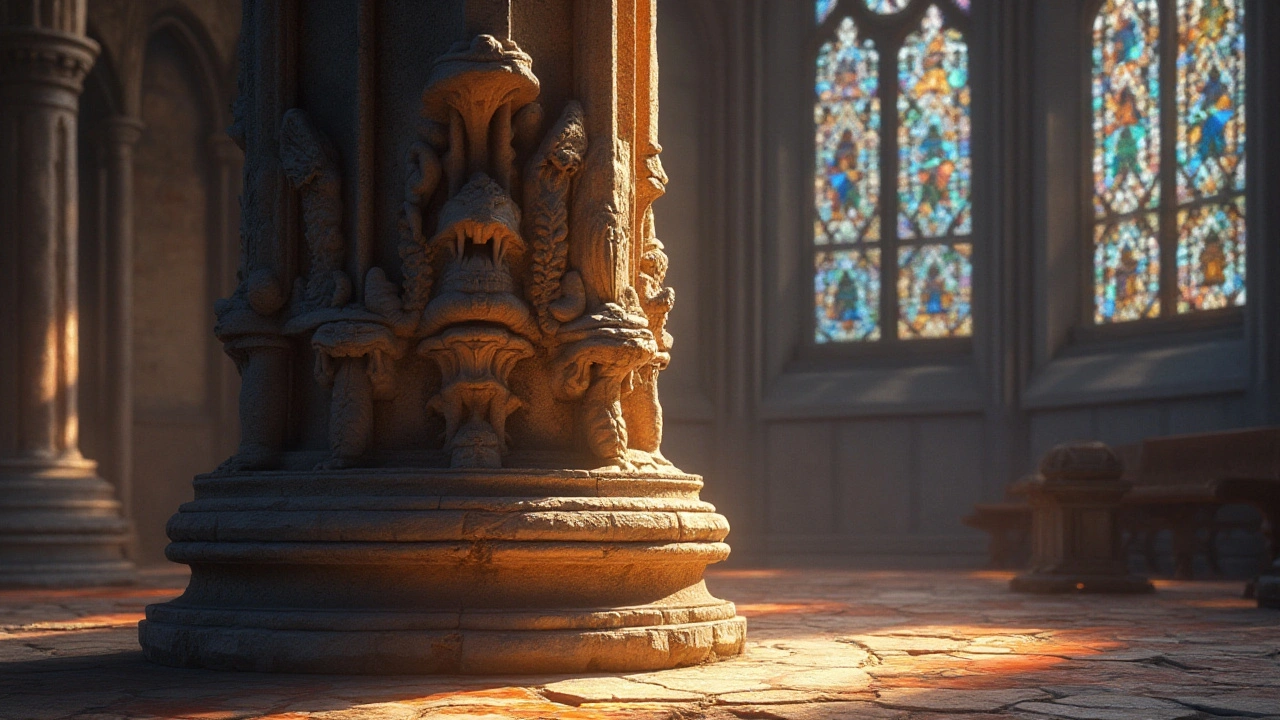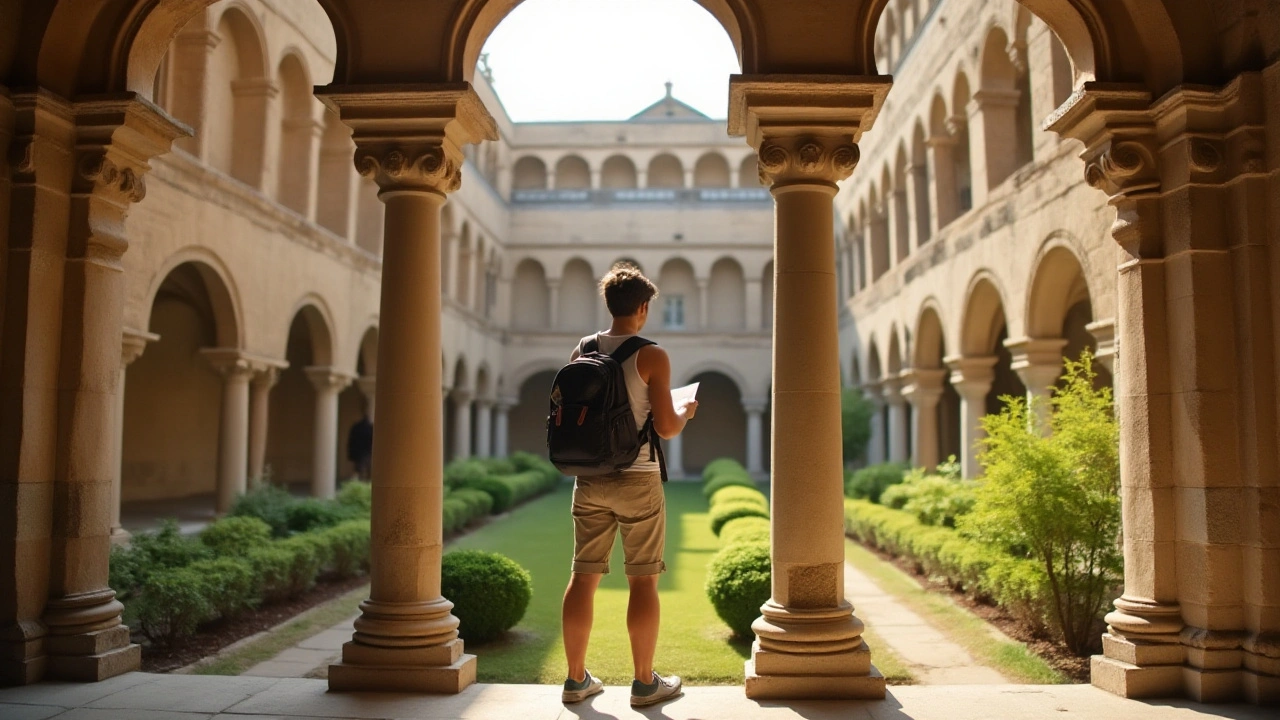Exploring Europe's Majestic Romanesque Architecture
 Oct, 21 2024
Oct, 21 2024
Romanesque architecture serves as a powerful testament to the ingenuity and creativity of medieval Europe. Known for its thick walls, round arches, and grand towers, this style encapsulates the spirit of the time. Strolling through a Romanesque structure feels like stepping into a historic narrative, rich with the echoes of the past.
Adventurers who traverse Europe’s towns and cities are in for a remarkable journey through history. The distinctive features of Romanesque architecture - such as the calm symmetry and the practical solidity - tell tales not just of artistic ambition but also of the socio-political climates that demanded and fostered such austere yet compelling forms.
The architectural language of Romanesque can be seen and felt in many of Europe’s cherished sites. This journey will reveal to you hidden gems and renowned halls alike, offering a canvas where stories of the old world are painted in stone and mortar.
- Origins and Characteristics
- Iconic Romanesque Sites
- Romanesque vs. Other Styles
- Experiencing Romanesque in Modern Times
Origins and Characteristics
Romanesque architecture, a style that shimmers with history and roots deeply dug into the European soil, offers an engrossing insight into medieval times. Around the 10th century, as Europe started finding its political and social feet post the jolts of the early Middle Ages, the Romanesque style began to take shape. With influences markedly picked from the robust and wine-dark Roman Empire's architectural styles, this era saw burgeoning of architecture that sought both protection and grandeur. At this time, powerful religious institutions played a pivotal role in shaping the architectural landscape. They influenced not just the design but also the symbolic elements carved into the stone and built into the very foundation of structures. This was a period ripe with the revival of monumental construction when the voice of the Church echoed through massive naves and barrel-vaulted ceilings.
One salient characteristic of Romanesque architecture is its extensive use of the semi-circular arch. This familiar curve provided not just beauty, but also practical strength to the building. The walls were frequently several meters thick, often giving the impressions of fortresses rather than places of worship. The higher the walls were, the more they reflected a sense of celestial aspiration. Structures like the Abbey Church of Sainte-Foy in France stand testament to this enduring strength and heavenly reach. As Bernard of Clairvaux, an influential monk of the time, reportedly opined:
"Beauty in the house of God is a detour through which the soul, long lost, finds its way back to its Creator."Yet, the period was more than just repeating Roman grandeur; it brought functional innovation. Features like groin vaults, which improved on simple barrel vaults by dispersing weight across four points, made it feasible to create large, open interiors without interruption from columns or walls.
The Romanesque style is also renowned for its detailed and expressive sculptural programs. Doors and capitals, those wonderfully decorated tops of columns, became areas of artistic storytelling. These sculptures often depicted religious scenes or moral lessons meant to educate a largely illiterate populace. Gargoyles were more than just decorative figures; they served as the architectural complement of the often sombre tone, acting as both a warning against sin and a channel for rainwater. The crowded, almost crude, creatures offered a stunning contrast to the solemn majesty of the structures they adorned, an eternal reminder of the age-old dichotomy between heaven and hell, beauty and beast.
From its solid foundations to its soaring towers, Romanesque architecture is defined by exuberant solidity and a confident reach toward the heavens. The basilica plan, often adapted to accommodate the flow of pilgrims, led to the construction of broad aisles and expansive transepts that gave structures a cruciform shape, characteristic of many of the large churches that grace this era. The Romanesque style laid down architectural roots that would later propagate into Gothic exuberance, much like planting seeds for future architectural blossoming. As enthusiasts and travelers travel across Europe today, from the mystic cloisters of Spain's Monastery of San Juan de Duero to the decorative splendour of Italy's Sant' Ambrogio Basilica, they are invited to traverse stories born from stone, each carved nook and arch a whisper from the past, beckoning from across centuries.
Iconic Romanesque Sites
Embarking on a journey to explore the Romanesque architecture of Europe is like leafing through a history book made of stone and light. One of the most celebrated sites is the Abbey of Cluny in France, which for centuries stood as the largest religious church until St. Peter's Basilica claimed the title. When visitors walk through what remains of this Benedictine abbey, they can almost hear the echoes of chants that once filled the vast, ornate halls. A place not just of worship but of power, it played a pivotal role in the monastic reform movement of the 10th century, influencing spiritual and political discourse across the continent.
Another jewel is the Cathedral of Saint James in Compostela, Spain. More than just an architectural feast, it is the culmination of the Camino de Santiago, a pilgrimage route that attracts visitors from all over the world seeking spiritual and physical rejuvenation. The architectural mastery of its façades and the brilliant designs inside reflect both the aspirations and religiosity of medieval Europe. As you enter, your eyes are drawn to the exquisite Portico of Glory, adorned with detailed sculptures that capture biblical stories. This magnificent edifice is not merely about its physical form but also the ethos and narratives it harbors.
In Italy, the Cathedral of Pisa is a testament to the unique amalgamation of diverse designs that define Romanesque buildings. Situated in the Piazza dei Miracoli, this cathedral is paired with the famed Leaning Tower and a magnificent baptistery. Created from the inventive mind of Buscheto, the cathedral incorporates classical, Byzantine, and Islamic elements that reflect Pisa’s cosmopolitan cocktail of influences during the 11th century. Its white and grey striped marble façade glows under the Tuscan sun, and as visitors marvel at its grandeur, they also get to witness the meridian line that Galileo Galilei is believed to have used for his astronomical observations.
In Germany, the Speyer Cathedral stands as one of the most important architectural landmarks, not just for its scale but for its imperial significance; it stands as a symbol of the Salian dynasty’s power. Its long nave and imposing dimensions make it one of the largest surviving Romanesque churches. Constructed from the distinct red sandstone that’s characteristic of the region, the cathedral's towers and domes make it visible for miles around, serving as a reminder of its historical significance. Here, the Romanesque style reaches its zenith in terms of size and sophistication, offering an unparalleled glimpse into the past.
These sites are just a few of the fascinating destinations that people passionate about historical buildings and architectural styles travel far and wide to see. They underline the diversity within the Romanesque tradition, each with its unique narrative and cultural blend. These locations are not mere relics but vibrant places where history and present intertwine, reflecting stories of piety, politics, and community. They continue to attract and inspire those who walk their storied halls, offering a deep connection to the roots of European heritage.

Romanesque vs. Other Styles
Diving into the world of architectural styles, one might easily lose themselves comparing the distinct features of each era. The Romanesque architecture, however, establishes its ground with an unmistakable identity. Known for its structural strength and austere beauty, Romanesque emerged in Europe during the late 10th century, lasting until the rise of the Gothic style in the 12th century. The defining characteristic of Romanesque buildings includes massive walls, sturdy piers, and a rhythmic sequence of arches, distinct from the pointed arches and flying buttresses often associated with Gothic architecture. Romanesque architecture holds onto nature’s solidity with semi-circular arches in contrast to the vertical, sky-reaching ambitions of the Gothic style.
Individual elements like the thick, heavy walls of Romanesque architecture served both symbolic and practical purposes. They conveyed the strength and enduring spirit of an institution, often reflecting the plain and devout ethos valued by communities at the time. In contrast, Baroque architecture, which flourished in the late 16th and 17th centuries, focused on grandeur, drama, and motion, expressed through weaving curves and elaborate decorations that captured the eye and dazzled the senses. Whereas Romanesque’s quieter style aims to anchor and ground, Baroque seeks to reach out, to evoke heightened sensory experiences, almost like a visual dance orchestrated in stone.
"Architecture should speak of its time and place, but yearn for timelessness." - Frank Gehry
Romanesque’s compact style might be contrasted with Renaissance architecture, which revived the order, balance, and aesthetics of classical antiquity. While the former often relied on the symbolic power of weight and repose, the Renaissance drew from harmony and proportion. Where Romanesque focused on community needs and ecclesiastical geometry, the Renaissance often turned to humanism and symmetry. Each carried immense cultural significance and offered a response to its time's aspirations, ambitions, and constraints. It’s a captivating journey through time to witness how Romanesque held firm amidst the shifting tides of architectural discourse.
Comparison in Material and Techniques
Material and technique form another arena where Romanesque architecture stands apart. Romanesque builders were pragmatic, using local stone or brick as their primary construction material—durability and availability often dictated their projects. By contrast, in the Gothic period, light and height were priorities, leading to innovations like the pointed arch and ribbed vault that necessitated a lighter stone skeleton supported by flying buttresses. Renaissance architecture embraced smooth marble and brilliant frescoes, embodying vitality and human-centric grace more than rugged religious endurance.
Grasping these distinctions provides more than just a chronological or stylistic marker of architecture. These differences touch the very essence of European history and culture. Romanesque is deeply entwined with the needs of a post-Roman world reorienting itself. It represents communities seeking connection to both heaven and earth, fortifying their presence in a changing world.

Experiencing Romanesque in Modern Times
Today, experiencing Romanesque architecture is akin to taking a walk through history, where each stone laid centuries ago narrates its own unique story. Modern travelers who seek more than just the typical tourist snapshot will find solace and inspiration in these ancient structures. Initially, it may appear as though time has paused, capturing the elegance and strength of a bygone era. Yet, upon closer inspection, the lively activity surrounding these sites reveals a thriving appreciation and continuous engagement with our shared past. Cultural activities frequently take place in these historical buildings, providing a dynamic atmosphere where history seamlessly intertwines with modern life.
Unlike other historic styles, Romanesque sites tend to be less crowded yet equally magnificent. The serene environment surrounding these structures encourages contemplation, and visitors often leave with a deeper understanding of how these architectural marvels were born out of necessity and faith. Among the most fascinating aspects of the Romanesque design is its adaptability. Today, many of these sites serve as vibrant centers for art, music, and intellectual pursuits. For instance, Fuentidueña Apse at The Met Cloisters in New York, originally from Spain, serves as an exemplary piece of Romanesque excellence, now part of a modern setting yet retaining its profound, awe-inspiring presence.
"Walking through a Romanesque structure is like reading history through the language of stone," remarked Charles McKay, a renowned historian, during an interview on historical architecture.
In regions where Romanesque architecture flourished, such as Europe, the structures have been ingeniously repurposed to fit modern needs. Event spaces inside ancient castles or churches provide unique atmospheres for occasions ranging from weddings to concerts. While preserving the historic essence, these sites are adapted to support modern amenities, creating a juxtaposition of the old and the new. This seamless blend accentuates the timeless quality of Romanesque design, emphasizing its enduring appeal.
For those eager to delve into the world of Romanesque architecture, there is no shortage of sights to explore. Across Europe, but widely in places like Italy and France, efforts are continually made to maintain and restore these buildings. Organizations frequently organize tours that span multiple countries, allowing travelers to fully immerse themselves in the geographical and stylistic variations of Romanesque design. Those involved in these preservation efforts often share a passion that is nothing short of contagious, making tours not just educational, but also deeply personal experiences.
| Country | Notable Sites |
|---|---|
| Italy | Lucca Cathedral, Basilica of Sant'Ambrogio |
| France | Abbey of Cluny, Notre-Dame la Grande |
| Spain | Santiago de Compostela, Church of San Martin |
These captivating journeys are often interspersed with opportunities to indulge in local culture and cuisine, turning each trip into a holistic cultural experience. As we continue to cherish and explore these monumental works, Romanesque architecture remains not only a symbol of historical achievement but also a source of contemporary inspiration. Through these structures, we are reminded that while progress is essential, preserving our roots allows us to appreciate where we’ve come from and inspire where we are heading.